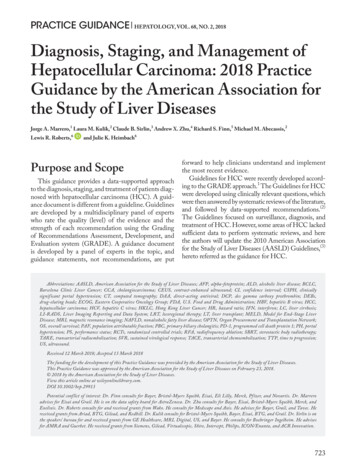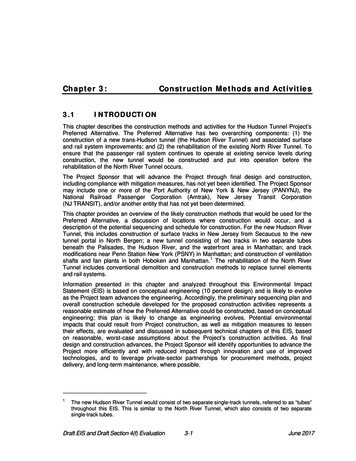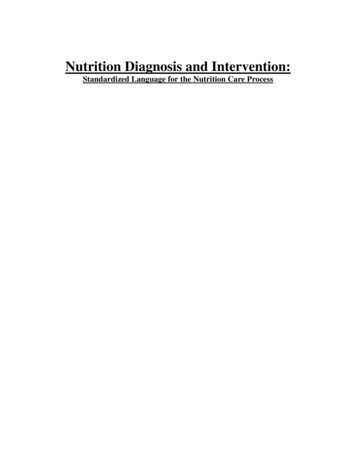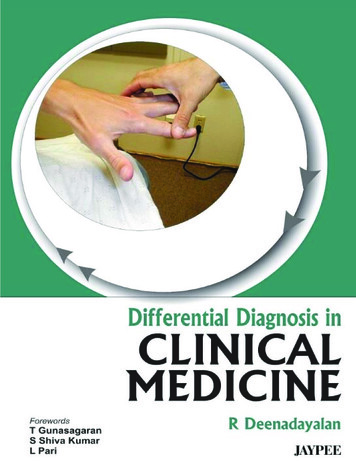
Transcription
PRACTICE GUIDANCE Hepatology, VOL. 68, NO. 2, 2018 VIRAL HEPATITISDiagnosis, Staging, and Management ofHepatocellular Carcinoma: 2018 PracticeGuidance by the American Association forthe Study of Liver DiseasesJorge A. Marrero,1 Laura M. Kulik,2 Claude B. Sirlin,3 Andrew X. Zhu,4 Richard S. Finn,5 Michael M. Abecassis,2Lewis R. Roberts,6and Julie K. Heimbach6Purpose and ScopeThis guidance provides a data-supported approachto the diagnosis, staging, and treatment of patients diagnosed with hepatocellular carcinoma (HCC). A guidance document is different from a guideline. Guidelinesare developed by a multidisciplinary panel of expertswho rate the quality (level) of the evidence and thestrength of each recommendation using the Gradingof Recommendations Assessment, Development, andEvaluation system (GRADE). A guidance documentis developed by a panel of experts in the topic, andguidance statements, not recommendations, are putforward to help clinicians understand and implementthe most recent evidence.Guidelines for HCC were recently developed according to the GRADE approach.1 The Guidelines for HCCwere developed using clinically relevant questions, whichwere then answered by systematic reviews of the literature,and followed by data-supported recommendations.(2)The Guidelines focused on surveillance, diagnosis, andtreatment of HCC. However, some areas of HCC lackedsufficient data to perform systematic reviews, and herethe authors will update the 2010 American Associationfor the Study of Liver Diseases (AASLD) Guidelines,(3)hereto referred as the guidance for HCC.Abbreviations: AASLD, American Association for the Study of Liver Diseases; AFP, alpha-fetoprotein; ALD, alcoholic liver disease; BCLC,Barcelona Clinic Liver Cancer; CCA, cholangiocarcinoma; CEUS, contrast-enhanced ultrasound; CI, confidence interval; CSPH, clinicallysignificant portal hypertension; CT, computed tomography; DAA, direct-acting antiviral; DCP, des gamma carboxy prothrombin; DEBs,drug-eluting beads; ECOG, Eastern Cooperative Oncology Group; FDA, U.S. Food and Drug Administration; HBV, hepatitis B virus; HCC,hepatocellular carcinoma; HCV, hepatitis C virus; HKLC, Hong Kong Liver Cancer; HR, hazard ratio; IFN, interferon; LC, liver cirrhosis;LI-R ADS, Liver Imaging Reporting and Data System; LRT, locoregional therapy; LT, liver transplant; MELD, Model for End-Stage LiverDisease; MRI, magnetic resonance imaging; NAFLD, nonalcoholic fatty liver disease; OPTN, Organ Procurement and Transplantation Network;OS, overall survival; PAF, population attributable fraction; PBC, primary biliary cholangitis; PD-1, programmed cell death protein 1; PH, portalhypertension; PS, performance status; RCTs, randomized controlled trials; RFA, radiofrequency ablation; SBRT, stereotactic body radiotherapy;TARE, transarterial radioembolization; SVR, sustained virological response; TACE, transarterial chemoembolization; TTP, time to progression;US, ultrasound.Received 12 March 2018; Accepted 13 March 2018The funding for the development of this Practice Guidance was provided by the American Association for the Study of Liver Diseases.This Practice Guidance was approved by the American Association for the Study of Liver Diseases on February 23, 2018. 2018 by the American Association for the Study of Liver Diseases.View this article online at wileyonlinelibrary.com.DOI 10.1002/hep.29913Potential conflict of interest: Dr. Finn consults for Bayer, Bristol-Myers Squibb, Eisai, Eli Lilly, Merck, Pfizer, and Novartis. Dr. Marreroadvises for Eisai and Grail. He is on the data safety board for AstraZeneca. Dr. Zhu consults for Bayer, Eisai, Bristol-Myers Squibb, Merck, andExelixis. Dr. Roberts consults for and received grants from Wako. He consults for Medscape and Axis. He advises for Bayer, Grail, and Tavec. Hereceived grants from Ariad, BTG, Gilead, and Redhill. Dr. Kulik consults for Bristol-Myers Squibb, Bayer, Eisai, BTG, and Grail. Dr. Sirlin is onthe speakers' bureau for and received grants from GE Healthcare, MRI, Digital, US, and Bayer. He consults for Boehringer Ingelheim. He advisesfor AMR A and Guerbet. He received grants from Siemens, Gilead, Virtualscopic, Shire, Intercept, Philips, ICON/Enanta, and ACR Innovation.723
MARRERO ET AL. Intended for use by health care providers, this guidance is meant to supplement the recently publishedHCC Guidelines in order to provide updated information on the aspects of clinical care for patients withHCC. As with other guidance documents, it is notintended to replace clinical judgment, but rather toprovide general guidance applicable to the majority ofpatients. They are intended to be flexible, in contrast toformal treatment recommendations, and clinical considerations may justify a course of action that differsfrom this guidance.EpidemiologyHCC is now the fifth-most common cancer in theworld and the third cause of cancer-related mortalityas estimated by the World Health Organization (globacan.iarc.fr). It is estimated that in 2012, there were782,000 cases worldwide, of which 83% were diagnosed in less developed regions of the world. The annual incidence rates in eastern Asia and Sub-SaharanAfrica exceed 15 per 100,000 inhabitants, whereas figures are intermediate (between 5 and 15 per 100,000)in the Mediterranean Basin, Southern Europe, andNorth America and very low (below 5 per 100,000)in Northern Europe.(4) Vaccination against hepatitis B virus (HBV) has resulted in a decrease in HCCincidence in countries where this virus was highlyprevalent.(5) These data suggest that the geographicalheterogeneity is primarily related to differences in theexposure rate to risk factors and time of acquisition,rather than genetic predisposition. Studies in migrantpopulations have demonstrated that first-generationimmigrants carry with them the high incidence ofHCC that is present in their native countries, but inthe subsequent generations the incidence decreases.(6)The age at which HCC appears varies according tosex, geographical area, and risk factor associated withcancer development. In high-risk countries with majorHepatology, August 2018HBV prevalence, the mean age at diagnosis is usuallybelow 60 years; however, it is not infrequent to observeHCC from childhood to early adulthood, underlyingthe impact of viral exposures early in life.(7) In intermediate- or low-incidence areas, most cases appear beyond60 years of age. In African and Asian countries, the diagnosis of HCC at earlier ages is attributed to a synergybetween HBV and dietary aflatoxins, which is thoughtto induce mutations in the TP53 gene.(8) Other factorssuch as insertional mutagenesis and family history couldplay a role in the development of HCC at earlier ages.In all areas, males have a higher prevalence than females,the sex ratio usually ranging between 2:1 and 4:1, and,in most areas, the age at diagnosis in females is higherthan in males.(4) Sex differences in sex hormones appearto be important as a risk factor for HCC. Testosteroneis a positive regulator of hepatocyte cell-cycle regulators,which, in turn, accelerates hepatocarcinogenesis, in contrast estradiol suppresses cell-cycle regulators therebysuppressing the development of liver cancer.(9)The incidence of HCC has been rapidly rising inthe United States over the last 20 years.(10) Accordingto estimates from the Surveillance EpidemiologyEnd Result (SEER) program of the National CancerInstitute (NCI), the United States will witness anestimated 39,230 cases of HCC and 27,170 HCCdeaths in 2016 (seer.cancer.gov). In addition, a recentstudy using the SEER registry projects that the incidence of HCC will continue to rise until 2030, withthe highest increase in Hispanics, followed by blacks,and then whites, with a decrease noted among AsianAmericans.(11)SurveillanceAT-RISK POPULATIONPreexisting cirrhosis is found in more than 80% of individuals diagnosed with HCC.(3) Thus, any etiological agent leading to chronic liver injury and, ultimately,ARTICLE INFORMATION:From the 1 UT Southwestern Medical Center, Dallas, TX; 2 Northwestern Medicine, Chicago, IL; 3 University of California SanDiego,SanDiego, CA; 4 Massachusets General Hospital, Boston, MA; 5 UCLA Medical Center, Los Angeles, CA; 6 Mayo Clinic, Rochester, MNADDRESS CORRESPONDENCE AND REPRINT REQUESTS TO:Jorge A. Marrero, M.D., M.S., M.S.H.M.UT Southwestern Medical CenterProfessional Office Building 1Suite 520L7245959 Harry Hines BoulevardDallas, TX 75390-8887E-mail: jorge.marrero@utsouthwestern.eduTel: 1-214-645-6216
Hepatology, Vol. 68, No. 2, 2018 MARRERO ET AL.TABLE 1. PATIENTS AT THE HIGHEST RISK FOR HCCPopulation GroupThreshold Incidence forEfficacy of Surveillance( 0.25 LYG; % per year)Incidence of HCCSurveillance benefitAsian male hepatitis B carriers over age 40Asian female hepatitis B carriers over age 50Hepatitis B carrier with family history of HCCAfrican and/or North American blacks with hepatitis BHepatitis B carriers with cirrhosisHepatitis C cirrhosisStage 4 PBCGenetic hemochromatosis and cirrhosisAlpha-1 antitrypsin deficiency and cirrhosisOther cirrhosis0.20.4%-0.6% per year0.20.3%-0.6% per year0.2Incidence higher than without family history0.2HCC occurs at a younger age0.2-1.53%-8% per year1.53%-5% per year1.53%-5% per year1.5Unknown, but probably 1.5% per year1.5Unknown, but probably 1.5% per year1.5UnknownSurveillance benefit uncertainHepatitis B carriers younger than 40 (males) or 50 (females)Hepatitis C and stage 3 fibrosisNAFLD without cirrhosis0.2 0.2% per year1.51.5 1.5% per year 1.5% per yearAbbreviation: LYG, life-years gained.cirrhosis should be considered as a risk factor for HCC.The major causes of cirrhosis, and hence HCC, areHBV, hepatitis C virus (HCV), alcohol, and nonalcoholic fatty liver disease (NAFLD), but less-prevalentconditions, such as hereditary hemochromatosis, primary biliary cholangitis (PBC), and Wilson's disease,have also been associated with HCC development. Asthe obesity epidemic progresses, the number of patientsdeveloping HCC on the background of NAFLD mayincrease.(12)The decision to enter a patient into a surveillanceprogram is determined by the level of risk for HCCwhile also taking into account the patient's age, overall health, functional status, and willingness and abilityto comply with surveillance requirements. The level ofHCC risk, in turn, is indicated by the estimated incidence of HCC. However, there are no experimental datato indicate the threshold incidence of HCC to triggersurveillance. Instead, decision analysis has been used toprovide some guidelines as to the incidence of HCC atwhich surveillance may become effective. In general,an intervention is considered effective if it provides anincrease in longevity of around 100 days (i.e., around 3months).(13) Interventions that can be achieved at a costof less than approximately USD (U.S. dollars) 50,000/year of life gained are considered cost-effective.(14)Several published decision analysis/cost-effectivenessmodels for HCC surveillance have reported that surveillance is cost-effective, although in some cases onlymarginally so, and most find that the effectiveness ofsurveillance depends on the incidence of HCC. Forexample, in a theoretical cohort of patients with ChildPugh A cirrhosis, Sarasin et al.(15) reported that surveillance increased longevity by around 3 months if theincidence of HCC was 1.5%/year; if the incidence waslower, surveillance did not prolong survival. Conversely,Lin et al.(16) found that surveillance with alpha-fetoprotein (AFP) and ultrasound (US) was cost-effectiveregardless of HCC incidence. Thus, although there issome disagreement between published models, surveillance should be offered for patients with cirrhosis ofvarying etiologies when the risk of HCC is 1.5%/yearor greater. Theabove cost-effectiveness analyses, whichwere restricted to populations with cirrhosis, cannotbe applied to hepatitis B carriers without cirrhosis. Acost-effectiveness analysis of surveillance for hepatitisB carriers using US and AFP levels suggested that surveillance became cost-effective once the incidence ofHCC exceeds 0.2%/year.(3)Table 1 shows the populations at risk for developingHCC. Incidence rates for HCC among patients withcirrhosis range from 1% to 8% per year, and precisiontools that better predict the development of HCC inindividual patients are needed. Unfortunately, previous predictive algorithms based on typical clinical riskfactors, such as age, sex, and degree of liver dysfunction, have suboptimal performance when externallyvalidated.(17) Recently, a tissue-based gene expression725
MARRERO ET AL. profile that predicts clinical progression in personswith HCV-induced cirrhosis(18) and the development of HCC in individuals with cirrhosis has beendeveloped.(19) For the 186-gene expression panel thatpredicts clinical progression, classification in the highrisk group was associated with significantly increasedrisks of hepatic decompensation (hazard ratio [HR] 7.36; P 0.001), overall death (HR 3.57; P 0.002), liver-related death (HR 6.49; P 0.001), and all liver-related adverse events (HR 4.98; P 0.001).(18)For prediction of HCC development, the 186-genepanel was reduced to a 32-gene signature implementedon the Nanostring platform. In an independent cohortof 263 surgically treated, early-stage HCC patients,the probability of developing HCC was nearly 4-foldhigher in patients with a high-risk prediction score(41%/year) compared to those with a low-risk prediction score (11%/year).(19) This panel looks promisingto better define which patients with cirrhosis are at riskfor development of HCC; however, it needs validationin serum as well as in different racial/ethnic groups andin different etiologies of liver diease before widespreaduse. In addition, multiple potential functional biomarkers have been identified and are currently undergoing validation for early detection and prediction ofHCC. These include the following markers: epithelialcell adhesion molecule, osteopontin, surface markervimentin, transforming growth factor beta/sirtuin, andDNA repair pathway members. These novel biomarkers reflect biological significance in HCC.(20-24)HBVThe evidence linking HBV with HCC is unquestioned.(25) Active viral replication is associated withhigher risk of HCC, and long-standing active infectionwith inflammation resulting in cirrhosis is the majorevent resulting in increased risk.(26,27) The incidence ofHCC in inactive HBV carriers without liver cirrhosis(LC) is less than 0.3% per year. The role of specificHBV genotypes or mutations in hepatocarcinogenesisis not well established, especially outside Asia. HBVDNA integrates into the host cellular genome in themajority of cases of chronic hepatitis B (CHB) andinduces genetic damage. DNA integration in nontumoral cells in patients with HCC suggests that genomicintegration and damage precede the development oftumor. Thus, infection with HBV may be correlatedwith the emergence of HCC even in the absence ofLC. However, most studies does show that the risk ofHCC increases markedly in those with cirrhosis.(28)726Hepatology, August 2018HCC incidence among patients without cirrhosisranged from 0.1 to 0.8 per 100 person-years whereasincidence in patients with cirrhosis ranged from 2.2 to4.3 per 100 person-years. There is strong evidence fromprospective cohort studies that persistent HBV e antigen and high levels of HBV serum DNA increase therisk of HCC. There is a multiplicative effect of heavysmoking and alcohol drinking in those with HBVinfection, increasing the risk of HCC 9-fold.(29) Theimplementation of vaccination against HBV, as well asantiviral treatment of HBV infection, has resulted in asignificant decrease of HCC incidence,(30) proof of theimportance of this virus in the genesis of HCC. Familyhistory of HCC in patients with CHB are at a significantly higher risk for developing HCC and shouldundergo surveillance.(31)HCVHCV is the most common cause of HCC in Westerncountries. Prevalence of HCV in HCC cohorts varies according to the prevelance of HCV within eachgeographical area. A large, prospective, population-based study evaluated the risk of HCC in patientswith HCV.(32) This study included 12,000 men anddescribed a 20-fold increased risk of HCC in infectedindividuals. Case series have suggested that HCC candevelop in HCV-infected patients without cirrhosis,but HCC incidence in the absence of advanced fibrosis(AF) is below 1% a year.(33) HCC risk sharply increasesafter cirrhosis develops, with annual incidence rangingbetween 2% and 8%.(34) In addition, in patients withcirrhosis the risk of HCC decreases, but is not completely eliminated even after a sustained response tointerferon (IFN)-based antiviral treatment.(35)Currently, well-tolerated combinations of direct-actingantivirals (DAAs) have largely replaced IFN-basedtherapy. The rates of sustained virological response(SVR) with combinations of DAAs exceed 95%.(36)Importantly, DAA therapy may lead to decreases inportal hypertension (PH) and change the natural history of patients with cirrhosis.(37) After initial concernthat the incidence of HCC following successful DAAtherapy appears to be higher than that observed afterIFN therapies, more recent and larger studies havedemonstrated that successful DAA therapy is associated with a 71% reduction in HCC risk.(38) However,patients with cirrhosis have continued risk of HCC,with HCC being reported even 10 years after SVR.DAA therapy against HCV infection reduces therisk of developing HCC. A recent study evaluated DAA
Hepatology, Vol. 68, No. 2, 2018 therapy for those who have already developed HCC.The single-center study included patients with HCVinfection and treated HCC who achieved a completeresponse.(39) A total of 58 patients with treated HCCreceived DAA and after a median follow-up of 5.7months; 3 patients died and 16 developed HCC recurrence. This study was followed by an analysis of threeprospective French multicenter cohorts of more than6,000 patients treated with DAA, of which 660 hadcurative therapy for HCC.(40) The authors found thatthere was no increased risk of HCC recurrence afterDAA treatment when compared to non-DAA-treatedcontrols. A systematic review performed on a total of41 studies (n 13,875 patients) showed no evidence ofincreased HCC recurrence risk in patients who achievedDAA-induced SVR compared to IFN-based SVR.(41)At this time, treating HCV infection should be performed after HCC is completely treated with no evidence of recurrence after an observation period of 3-6months.(42)NAFLDIt has been estimated that the world-wide prevalenceof NAFLD is around 25% and it is likely to continueto increase.(43) An association between NAFLD andHCC is well established.(12) In a study comparing theincidence of HCC among patients with HCV infectionand NAFLD,(44) 315 patients with cirrhosis secondaryto HCV and 195 with cirrhosis attributed to NAFLDwere followed for a median of 3.2 years. Cumulativeincidence of HCC was 2.6% in the NAFLD groupcompared to 4% in the HCV group (P 0.09). In alarge Japanese study, those with NAFLD and AF hada 25-fold increase in development of HCC comparedto those without fibrosis.(45) The best available evidence suggests that NAFLD-related cirrhosis is a riskfactor for HCC, but at a lower rate compared to HCVrelated cirrhosis though the annual incidence rate innonalcoholic steatohepatitis cirrhosis remains higherthan 1%. HCC has also been observed in NAFLDpatients without cirrhosis, but incidence rates at lowerthan 1% a year.(46,47) Additional high-quality prospective studies are needed to confirm these observations.Although it is clear that NAFLD portends a lower riskfor HCC than HBV or HCV, the high prevalence ofNAFLD in the population underlies the importanceof NAFLD in the development of HCC.The population attributable fraction (PAF) is thequantifiable contribution of a risk factor to a diseasesuch as HCC. It is important for pursuing preventionMARRERO ET AL.of disease or interventions that may reduce diseaseburdens. A population-based study of 6,991 patientswith HCC older than 68 years evaluated the PAF.(48)The study showed that eliminating diabetes and obesity has the potential for a 40% reduction in the incidence of HCC, and the impact would be higher thaneliminating other factors, including HCV. Therefore,targeting the features of metabolic syndrome could bean important area for the prevention of HCC.OTHER ETIOLOGIES OF LIVERDISEASEAlcohol-related cirrhosis is also associated with thedevelopment of HCC. The proportion of HCC attributed to alcoholic liver disease (ALD) has beenconstant, between 20% and 25%.(49) The risk of HCCamong patients with alcoholic cirrhosis (AC) rangesfrom 1.3% to 3% annually.(50) The PAF for ALD is estimated to be between 13% and 23%, but this effect ismodified by race and sex. Importantly, the effect of alcohol as an independent risk factor for HCC is potentiated by the presence of concurrent factors, especiallyviral hepatitis.(48) Therefore, cirrhosis related to ALDremains an important risk factor for developing HCC.Other causes of cirrhosis can also increase the riskof HCC. In a population-based cohort of patientswith hereditary hemochromatosis and 5,973 of theirfirst-degree relatives, the authors found that 62 patientsdeveloped HCC with a standardized incidence ratioof 21 (95% confidence interval [CI], 16-22).(51) Menwere at higher risk than women, and there was noincident risk for nonhepatic malignancies. Cirrhosisfrom PBC is also an important risk factor. In a studyof 273 patients with cirrhosis from PBC followed upfor 3 years, the incidence rate was 5.9%.(51) In a recentsystematic review, a total of 6,528 patients with autoimmune hepatitis (AIH) had a median follow-up of8 years were evaluated for HCC incidence.(52) Thepooled incidence rate in the study was 3.1 per 1,000person-years, indicating that AIH-related cirrhosis is arisk factor for HCC. In a prospective study of patientswith cirrhosis attributed to alpha-1 antitrypsin deficiency, the annual incidence rate of HCC was 0.9%after a median follow-up time of 5.2 years.(53)Given that the goal of HCC surveillance is to improvesurvival, this should be performed in patients who are eligible for HCC-related treatments. Therefore, past studieshave suggested that HCC surveillance should be performed in patients with Child A or B cirrhosis, but is notbeneficial in Child C patients outside of liver transplant727
MARRERO ET AL. (LT) eligibility. Moreover, if a patient's age, medicalcomorbities, or poor performance status (PS; i.e., wheelchair bound) are clinically significant, then it is unlikelythat these patients would have a survival benefit fromsurveillance for HCC. There are no studies that haveindicated the best surveillance strategy for those on theLT waiting list, though clearly surveillance for HCC isindicated given the potential for curative therapy with LT.Pediatric HCC is the second-most common hepaticmalignancy in this population and often occurs in theabsence of cirrhosis. A population-based study identified218 cases of HCC in a pediatric population aged 18years, and the overall incidence rate was 0.05 per 100,000individuals.(54) Importantly, the authors show that overthe past four decades, the incidence of HCC has remainedstable in this population. HCC has been detected in pediatric patients with HBV, biliary atresia, primary sclerosingcholangitis, Fanconi's syndrome, hereditary tyrosinemia,and glycogen storage disease type IA. However, theannual incidence in these patients appears to be low.Guidance Statements Adult patients with cirrhosis are at the highestrisk for developing HCC and should undergosurveillance. The risk of HCC for patients with HCV-relatedcirrhosis who develop SVR after DAA treatment islowered, but not eliminated, and therefore patientswith cirrhosis and treated HCV should continue toundergo surveillance. T he risk of HCC is significantly lower in thosewith HCV or NAFLD and no cirrhosis comparedto those with cirrhosis, and surveillance is not recommended for these patients.surveillance testing1A. The AASLD recommends surveillance ofadults with cirrhosis because it improves overallsurvival (OS).Quality/Certainty of Evidence: ModerateStrength of Recommendation: Strong1B. The AASLD recommends surveillance usingUS, with or without AFP, every 6 months.Quality/Certainty of Evidence: LowStrength of Recommendation: Conditional1C. The AASLD recommends not performingsurveillance of patients with cirrhosis with Child’sclass C unless they are on the transplant waiting list,given the low anticipated survival for patients withChild's C cirrhosis.728Hepatology, August 2018Quality/Certainty of the Evidence: LowStrength of Recommendation: ConditionalTechnical Remarks1. It is not possible to determine which type of surveillancetest, US alone or the combination of US plus AFP,leads to a greater improvement in survival.2. The optimal interval of surveillance ranges from 4 to 8months.3. Modification in surveillance strategy based on etiology ofliver diseases or risk-stratification models cannot be recommended at this time.Based on a recent systematic review of the availableevidence, the current AASLD Guideline recommendssurveillance for individuals with cirrhosis as shownin Table 1.(2) The modalities recommended for surveillance are liver US with or without AFP every 6months. US, with or without AFP, is recommendedfor surveillance because most of the studies showeda benefit of the combination of US and AFP in improving OS.(55) Comparing AFP and US is not possible in the current available studies, and future studiesshould evaluate the true complementary nature of USand AFP. A recent study showed that the harms ofsurveillance (mostly related to false positives and indeterminate tests) were more often associated with USwhen compared to AFP.(56) It has been estimated that20% of US are classified as inadequate for surveillance,and alternative surveillance modalities may be neededin those with inadequate surveillance US such as inobesity, alcohol, and NAFLD-related cirrhosis.(57)Recently, guidelines have been developed for howsurveillance US exams should be performed, interpreted, and reported.(58) In this system, an US examis considered negative if there are no focal abnormalities or if only definitely benign lesions such as cystsare identified. An exam is considered nondiagnostic ifthere are lesions measuring 10 mm that are not definitely benign. An exam is considered positive if thereare lesions measuring 10 mm. A 10-mm thresholdis used because lesions 10 mm are rarely malignant.Even if malignant, such nodules are difficult to diagnose reliably because of their small size and, so longas the patient is in regular surveillance, they may befollowed safely. By comparison, lesion(s) 10 mm havea substantial likelihood of being malignant,(59) they areeasier to diagnose reliably, and there is greater risk ofharm from delaying the diagnosis.AFP is considered positive if its value is 20 ng/mLand negative if lower. Based on receiver operating curve
Hepatology, Vol. 68, No. 2, 2018 analysis, this threshold provides a sensitivity of around60% and a specificity of around 90%.(60) Assuming a5% prevalence of HCC (around that expected in theHCC surveillance population), this is expected to provide 25% positive predictive value for HCC. Moreover,the addition of AFP is expected to increase the sensitivity of surveillance US, although the magnitude ofthe incremental gain is not yet known. More recentdata suggest that longitudinal changes in AFP mayincrease sensitivity and specificity than AFP interpreted at a single threshold of 20 ng/mL.(61) Othersuggested strategies to increase AFP accuracy haveincluded use of different cutoffs by cirrhosis etiologyand AFP-adjusted algorithms.(62)In addition to AFP, a number of other biomarkershave been evaluated for surveillance. These include theLens culinaris lectin-binding subfraction of the AFP,or AFP-L3%, which measures a subfraction of AFPshown to be more specific, although generally less sensitive than the AFP,(63) and des gamma carboxy prothrombin (DCP), also called protein induced by vitaminK absence/antagonist-II, a variant of prothrombin thatis also specifically produced at high levels by a proportion of HCCs.(64‒67) These biomarkers are U.S. Foodand Drug Administration (FDA) approved for riskstratification, but not HCC surveillance, in the UnitedStates. In the past few years, a diagnostic model hasbeen proposed that incorporates the levels of each ofthe three biomarkers, AFP, AFP-L3%, and DCP, alongwith patient sex and age, into the Gender, Age, AFPL3%, AFP, and DCP (GALAD) model.(68) GALADhas been shown to be promising in phase II (case-control) biomarker studies, but still requires phase III andIV studies to evaluate its performance in large cohortstudies.There is also active development of novel cancerbiomarker assays, including assays for cancer-specificDNA mutations, differentially methylated regions ofDNA, microRNAs, long noncoding RNAs, native andposttranslationally modified proteins, and biochemicalmetabolites. Recent results suggest that there is differential expression of many biomolecules in exosomesreleased from tumor cells compared to those from normal cells.(69)The NCI's Early Detection Research Network hasprovided a guide for the clinical development of surveillance.(70) Therefore, the prospective-specimen-collection, retrospective blind evaluation (PRoBE) designis recommended for developing new biomarkers asclinical tools, including the ones discussed above,before a recommendation to their use be given.MARRERO ET AL.Despite their high diagnostic performance,cross-sectional, multiphase, contrast-enhanced computed tomography (CT) or magnetic resonanceimaging (MRI) are not recommended for HCCsurveillance given the paucity of data on their efficacy and cost-effectiveness. However, a recent cohort
advises for Eisai and Grail. He is on the data safety board for AstraZeneca. Dr. Zhu consults for Bayer, Eisai, Bristol-Myers Squibb, Merck, and Exelixis. Dr. Roberts consults for and received grants from Wako. He consults for Medscape and Axis. He advises for Bayer, Grail, and Tavec. He received grants from Ariad, BTG, Gilead, and Redhill. Dr.










